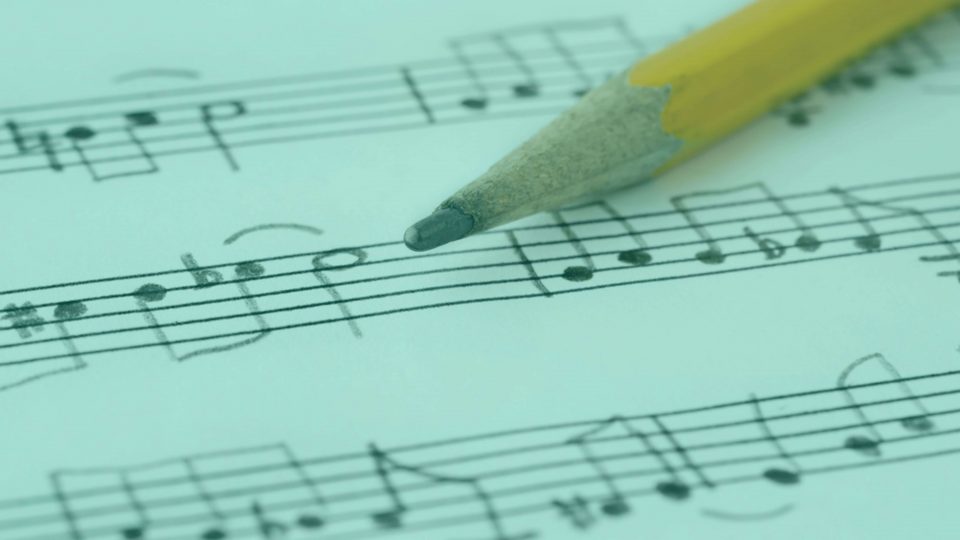What is Transcription in Music Production?
Transcription is the process of listening to a piece of music and notating it down note for note. Whether you notate it down in traditional sheet music, tablature, or your own style of notation, notating music is about understanding the structure of a song you’re listening to.
Music transcription is all about the analysis of an acoustic musical signal. the aim is to grasp and write down the pitch, onset time, duration, and source of each sound that occurs in it. In Western sheet music, we use note symbols to direct the performer of these parameters in a particular piece of music.
Besides musical notation, transcription in music production can actually take a multitude of forms.
Where a pianist may find it convenient to read note symbols that describe the key signature, a computational transcription system would work with a MIDI file or a spectrograph for musical notations.
In sheet music, time flows from left to right and the pitch of the notes are described by their vertical position on the staff lines. The amplitude of the instrument, however, is not usually specified for individual notes but is for larger phrases.
All of these transcriptions capture important musical information that describes the song in question. This information is fantastic for covering or even synthesizing the music.
Think of sheet music transcription as learning the recipe of a meal to make it yourself, and look at computational music transcription as reverse-engineering the digital data of a music signal.
A complete musical transcription accounts for the pitch, sequence, duration, and instrument(s) of the song be notated.
Why Transcribe Music?
Musc transcription is an immersive musical activity to practice and develop your own musical ear! If your pocket can’t afford a songbook of sheets or you can’t find a tab of a song you’re really digging, you’ll be breaking down the song yourself and learning the music you’ve not been able to find anywhere…or don’t want to pay for!
How to Start Transcribing Music Yourself
Writing your first transcription is easier than you may think. Sites such as Ultimate Guitar have their own built-in, cloud-based, tab editor. Noteflight, on the other hand, hosts free online sheet music software. For the guitarists out there, there are communities such as Ultimate Guitar for tablature, and Jellynote for sheet music.
Or you could load up your DAW’s piano roll, or internal sheet music editors if it supports them.
Another handy tool for transcribing is a plugin or program that slows a track down so that you can transcribe it. As well as slowing the track down, they also enable you to loop sections. It often takes several listens to fully work out what notes are being played (even for experienced transcribers)! Especially a long flurry of notes, as is often the case in jazz and rock solos.
you can find free browser plugins for Youtube that slow down and loop tracks. If you have the tracks downloaded to your computer, you can use your DAWs to time stretch and EQ tracks for easier transcriptions.
‘Amazing Slow Downer’ has similar functionality as we’ve discussed, but it also features keyboard commands for quick looping of certain sections.
If you’re transcribing a track so that you can cover it, you’ll need your instrument and also headphones if you’re in a not so quiet environment.
Transcription Quick Tips
- Start simple! A minor 12-bar blues progression is often just 3 chords, and usually sticks to the minor blues scale. A great one to start with is ‘Without You’ by Fleetwood Mac. Once you’ve got a bit of confidence you can start moving onto more complex things, but it’s best to ease yourself into the process.
- Work out the key of the track first. Many songs stick to one key with a specific set of notes. You’ll find it easier working out which notes are most likely to be used if you know the key. It’s a worthy time investment to learn your keys and scales.
- Don’t be afraid to slow the music right down. Working out a fast passage is well worthwhile, but if you’re struggling to hear the individual notes then there’s nothing wrong with slowing it down.
- Transcribe phrase by phrase. It’s much easier to make progress transcribing a song by working out a few notes at a time, rather than listening to 30 seconds of audio over and over and struggling to work it out.
- If you’re working out the chords, listen to what the bass is doing. More often than not in modern music, the bass note played on the first beat of a phrase is the root of the chord being played!
Transcription is a great way to understand and then reimagine your favourite songs. we know a place where you can find all the audio tools you’ll need to recreate any song you desire.
The sampling revolution has risen in popularity and shaped music since the early 1970s. Sample culture continues to transform how millions of artists and producers do their thing in DAWs.
You too can break conventional norms, challenge the status quo, and open Pandora’s box of sound design.
Mixxed works with a growing number of sample labels and contributors to provide you with a premium sample subscription service that’s more accessible than any before.
You’ll have access to our growing catalogue of loops, one-shots and sound effects that you can browse, download and keep forever for less than $3 a month.
Sign up today to find your sound!
